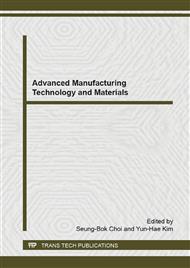p.167
p.172
p.181
p.185
p.190
p.194
p.198
p.202
p.206
High Adhesive Superhydrophobicity and Wetting Mechanism of Locust Wing Surface
Abstract:
The complex wettability, chemical composition and microstructure of locust wing surface were investigated by a video-based contact angle (CA) meter, a Fourier transform infrared spectrometer (FT-IR) and a scanning electron microscope (SEM). A model for hydrophobicity of wing surface was established on the basis of Cassie equation. The wetting mechanism was discussed from the perspective of biological coupling. The wing surface is a waxy layer composed mainly of long chain hydrocarbon, tallate and fatty-acid alcohol, possesses multiple-dimensional rough microstructures including primary structure (wing vein grids), secondary structure (regularly arraying micrometric pillar gibbosities), and tertiary structure (nanocorrugations). The diameter, height, and spacing of pillar gibbosity are 3.0~10.2 μm, 3.4~9.2 μm, and 7.5~18.5 μm, respectively. Locust wing surface is of high adhesive superhydrophobicity (CA 150.1~157.3°). The complex wettability of the wing surface ascribes to coupling effect of material element (waxy crystal) and structural element (hierarchical rough microstructure). Locust wing can be potentially used as a biomimetic template for design of special functional surface. This work may bring insights for preparation of micro-controllable superhydrophobic surface and no-loss microfluidic channels.
Info:
Periodical:
Pages:
190-193
Citation:
Online since:
January 2015
Price:
Сopyright:
© 2015 Trans Tech Publications Ltd. All Rights Reserved
Share:
Citation:


